Asus M4A785TD-M EVO AMD Motherboard Review
Asus M4A785TD-M EVO AMD Motherboard
Looking to build a Micro-ATX AMD-based system? Asus' M4A75TD-M EVO might be just the thing.
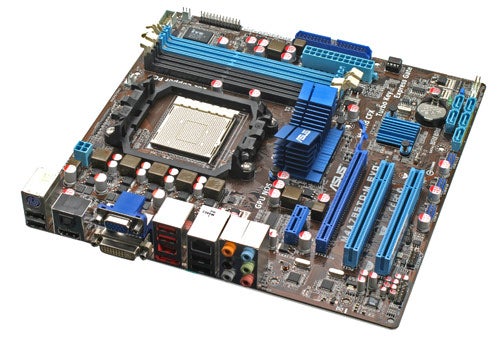
Verdict
Key Specifications
- Review Price: £68.20
If the title of this review elicits a feeling of déjà-vu, don’t worry, you’re not wrong and we’re not reviewing the same product twice. Notice that the Asus M4A785TD-V EVO we reviewed a while back has a ‘V’-suffix after the main model number, while the board we’re looking at today is the M4A785TD-M. What difference does this one letter make? Well, quite a bit, actually, as the ‘M’ stands for Micro-ATX, meaning this newer model will fit into far smaller cases. 
What with the exciting new Intel P55 chipset (as found in the recently-reviewed MSI P55-GD65) doing the rounds, we haven’t done an AMD-based board in a while – but despite providing truly excellent value for money, Intel’s P55-based Core i5/7 processors still aren’t within everyone’s price range. If you’re limited to the low end of the budget market, AMD’s versatile AM3-based boards are still a great option, especially as they’re compatible with almost every AMD CPU since the socket-939 days and look to be compatible with future models for a good while yet.
If we had any complaint with the Asus M4A785TD-V EVO, it was that the excellent HD 4200 integrated graphics core in its AMD 785G chipset was not reaching its full potential in an ATX-sized motherboard, as those wanting to build a home theatre PC (HTPC) would usually be looking for something to fit in a small form factor (SFF) system. Of course there’s also a market segment for those that just want a simple workhorse PC, for which integrated graphics are perfectly adequate, but arguably that same crowd would still want a small PC if possible. Let’s see then if the M4A785TD-M is a good option.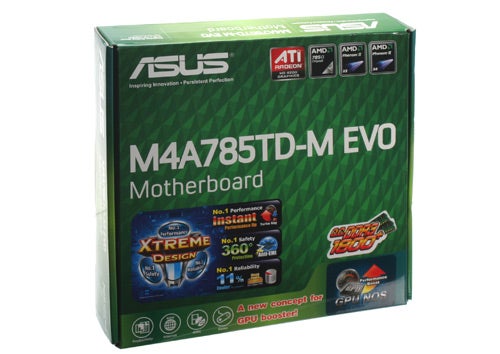
To begin with, let’s take a quick look at the basic specifications. Based on AMD’s 785G chipset paired with the SB710 southbridge, the board supports AM3 processors but is backwards compatible with AM2, so even older AMD CPUs should have no problem. For memory you’re limited to DDR3, which until recently was the more expensive option (compared to the DDR2 many AMD motherboards support) but has now come down in price to a point where there’s no longer a significant difference.
The included bundle is very sparse considering this board – while hardly high-end – isn’t exactly the cheapest model in Asus’ line-up. All you get in addition to the manual and single driver disk is an EIDE cable and two black SATA cables, one of which has an angled connector.
As expected from Asus, the M4A785TD-M EVO is a neat and attractive affair, clothed in a combination of brown for the PCB and various blues for the slots. While not as impressive as MSI’s P55-GD65, it certainly won’t put your other components to shame. 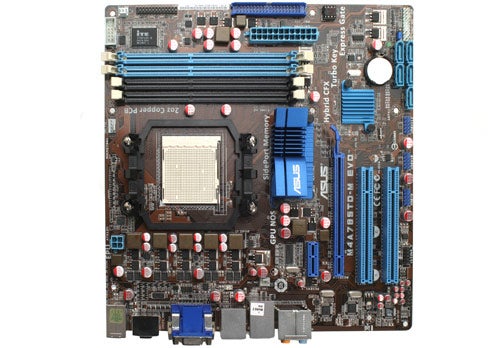
Layout is spot-on, with no unnecessary legacy connectors or ports. Next to the CPU socket is a flared heat-sink sporting blue metal fins, which should be more than adequate to cool the northbridge, while a tiny, unobtrusive heatsink takes care of the southbridge. The four memory slots, which can take DDR3 memory up to 1,800MHz, are thankfully staggered to allow better airflow around them when only using two, though not colour-coded to match.
Compared to its bigger brother, the M4A785TD-M has sacrificed one PCI slot and one PCIe x16 slot. However, as this second x16 slot only ran at x4 with a second card installed you couldn’t run CrossFire properly anyway, so its absence is no loss. This board still has everything you need for the average build, including one PCIe x1 slot, the aforementioned x16 slot and two ‘old’ PCI slots. 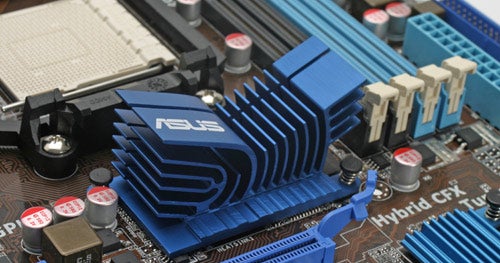
What the M EVO does offer is Hybrid CrossFireX, which basically refers to the board’s ability to run its integrated HD 4200 in tandem with a discrete graphics card. While this doesn’t bring the same power-saving that the mobile implementation does, there are quite a few benefits. The most obvious of these is better gaming performance, though you can’t pair the HD 4200 with anything very powerful if you want it to keep up. In fact, AMD suggests an HD 3400-series discrete GPU as the best partner, and as a combo this will still be outperformed by something as humble as a discrete Radeon 4750.
A more significant – if rather niche – advantage is that you can run four monitors from this hybrid configuration. Of course, you can just ignore the integrated graphics altogether and stick in the best card you can for some serious gaming – like the HD 5870 (which will also give you multiple simultaneous monitor outputs with EyeFinity), though good luck fitting it into a small case.
There are five standard SATA slots, and that’s about it as the M EVO lacks fancy extras such as reset buttons or overclocking switches. Getting onto the motherboard’s rear I/O connectivity, we have a very generous arrangement. First up is a PS2 keyboard port, though thankfully the mouse equivalent is omitted. Six USB ports is average, but there’s both FireWire and eSATA, which are both sometimes omitted on much more expensive boards.
Video connections are especially well provided for, with VGA, DVI and HDMI covering all the options. Aside from the digital audio carried over HDMI, Asus also offers optical digital and six 3.5mm jacks for eight-channel surround sound from the integrated VIA VT1708S HD chip. Last but not least there’s a Gigabit Ethernet port.
Getting onto the software, unfortunately the usual Express Gate instant-on OS needs to be installed on a hard drive rather than included on a memory chip as with more expensive Asus boards such as the P7P55D Deluxe. Hence, if you try enabling Express Gate without installing it to the hard drive first the board will throw up an error message (though on our first boot-up it just crashed completely, but this was a once-off). Once activated though, it will allow you to perform basic tasks like web-browsing, chat, Skype and multimedia functions almost from the moment you press the power button.
The included CD is rather disappointing in that it refused to work, though ideally you should always get the latest drivers and applications from the manufacturer’s website anyway.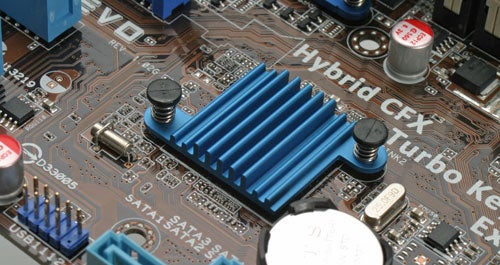
Getting onto the BIOS, it’s not as clear and logically laid out as we’re used to from Asus. Things are all over the place and sometimes unintuitively named; for example, most of the overclocking settings are found under the heading of JumperFree Configuration, though a few settings have snuck in under CPU Configuration.
Time to find out how this board performs when the pedal is put to the metal in the hardware department. As ever with AMD-based systems, overclocking is a piece of cake. Though the Phenom II processor we used was a 2600MHz X4 810 rather than one of the famed Black Edition CPUs, all you need to do for hassle-free overclocking is to raise the CPU/HT clock. On air cooling and without raising the voltage we got as far as 237 (up from the default 200) before the system started showing signs of instability, but everything ran rock solid at 235, which returned clock speeds of 3,065GHz for all the 810’s four cores. 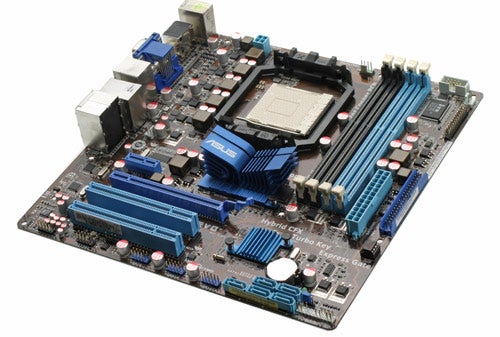
This is quite decent, and certainly not bad for what by all appearances should be a budget board – especially as it soundly thrashes Gigabyte’s MA785GMT-UD2H microATX board based on the same AMD 785G chipset. As the Asus also offers a cleaner layout and supports higher O.C. memory speeds it would seem we have a clear winner here. Thankfully it’s a reasonably priced board to boot, and can be yours for £68.20. At a mere £4 premium over its Gigabyte rival, it deserves serious consideration in the affordable Micro-ATX motherboard segment.
Verdict
Despite a few flaws, a sparce bundle and slightly confusing BIOS, Asus’ M4A785TD-M EVO delivers in the performance stakes and looks good doing it. For the price, we really can’t complain.
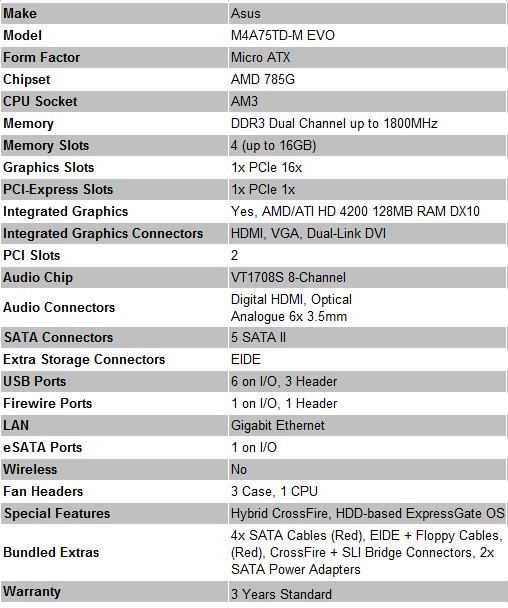
Trusted Score
Score in detail
-
Value 8
-
Features 8
-
Performance 8

